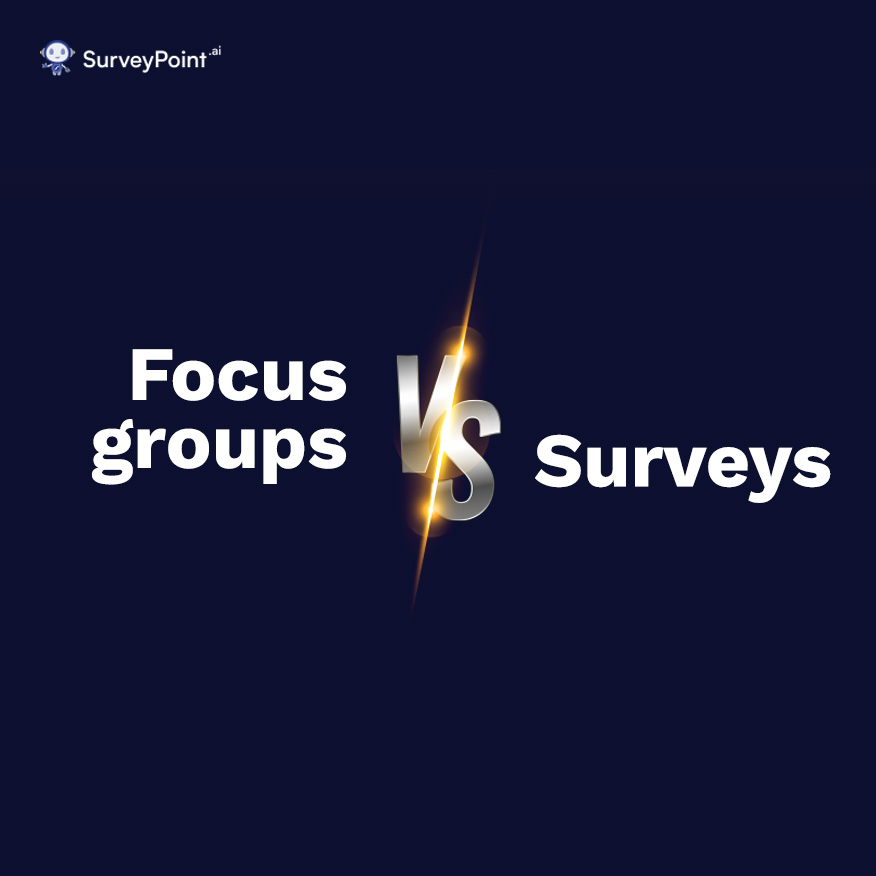
Focus groups vs surveys are both valuable tools in the world of research. But they serve different purposes and have unique strengths and weaknesses.
Both have their own strengths and weaknesses, and they can be used for different purposes. In this article, we’ll look at focus groups and surveys, comparing their attributes, objectives, advantages, and disadvantages.
But which of these methods yields better insights? To answer that, let’s dive into each approach.
Qualitative Vs. Quantitative Approach
Before we dive into both approaches, it’s good to know about the two main ways we do market research: quantitative and qualitative.
Usually, we use surveys for one and focus groups for the other.
| Qualitative Research | Quantitative Research | |
| Definition | Qualitative research is a method that is generally used to understand deep, complex phenomena. It seeks to explore the ‘why’ and ‘how’ of decision-making. | Quantitative research, on the other hand, is a method that aims to quantify data and apply some form of statistical analysis. It is used to quantify attitudes, opinions, behaviors, and other defined variables. |
| Data | Data is primarily in words, images, and objects. It’s subjective and rich in depth but difficult to generalize. | Data is primarily in numbers and statistics. It’s objective, precise, and can be generalized. |
| Method | Data is collected through methods like individual interviews, focus groups, observations, and document reviews. | Data is collected through methods like surveys, questionnaires, and experiments. |
| Analysis | Data is analyzed through thematic analysis, content analysis, grounded theory methodology, etc. | Data is analyzed using statistical tests and models. |
| Results | Findings are more detailed, offering rich context and deep insights into the research problem. | Findings can be presented with more numerical clarity, offering measurable and testable results. |
| Goal | The goal is to explore a topic more in-depth, often in a narrative or descriptive manner. It’s about understanding the human experience and behavior. | The goal is to quantify the data and generalize the results from the sample to the population of interest. It’s about measuring the incidence of various views and opinions in a chosen sample. |
| Strengths | Provides depth and detail, looks at processes, can study individuals and interactions in their natural settings. | Provides breadth and allows for wider study, collects a large amount of data for detailed analysis, results can be extrapolated to a larger population. |
| Weaknesses | Can’t generalize results, quality and reliability heavily depend on individual researcher’s skills, harder to make systematic comparisons. | Might miss contextual details, require a clear hypothesis at the beginning, and may oversimplify human behavior by relying on categories and statistical data. |
| Best used for | Developing a hypothesis or theory, understanding how or why things are as they are, exploring experiences or stories. | Confirming hypothesis, comparing variables, and making predictions about future outcomes. |
Both qualitative and quantitative research are valuable for different reasons. Often, the most comprehensive research strategies involve a mix of both qualitative and quantitative methods.
Understanding Focus Groups
Focus groups involve gathering a small number of individuals, typically 6-10, to participate in a moderated discussion about a particular topic. The purpose of a focus group is to generate qualitative insights through an open and interactive dialogue. This helps researchers understand what participants think and why they think that way.
Here are some advantages of focus groups:
- Rich, Qualitative Data: Focus groups provide in-depth insights into the participants’ thoughts, perceptions, and experiences. The interactive nature encourages discussions that can uncover nuanced insights and new ideas.
- Dynamic Interaction: The group setting allows for interaction between participants. This dynamic can stimulate new thoughts or ideas that might not emerge in an individual response to a survey.
- Immediate Probing: Researchers can ask follow-up questions or probe deeper into topics that arise during the discussion, something not possible with surveys.
- Non-Verbal Communication: Researchers can gather additional data through observing body language, tone of voice, and other non-verbal cues that provide more depth to the responses.
However, focus groups also have their limitations:
- Limited Representativeness: Due to the typically small size of focus groups, the findings may not be generalizable to a larger population.
- Group Influence: Participants’ responses may be influenced by more vocal or persuasive group members, which can skew results.
- Logistical Challenges: Organizing focus groups can be more time-consuming and expensive than surveys, requiring a suitable venue, coordination of schedules, and potential travel costs.
- Analysis Complexity: Qualitative data from focus groups can be complex and time-consuming, requiring significant expertise.
The Power of Surveys
Surveys involves administering a set of predetermined questions to a larger group of participants. They are designed to collect quantifiable data from a representative population sample. Further enabling researchers to make generalizations about a larger group based on the sample’s responses.
Advantages of surveys include:
- Broad Reach: Surveys can reach a large number of people across geographical locations, providing more representative data.
- Quantifiable Data: Surveys often produce quantitative data that can be easily analyzed statistically.
- Cost and Time Effective: Surveys, particularly online ones, are generally quicker and less expensive to administer than focus groups.
- Anonymity: Surveys can provide a greater sense of anonymity, which might lead to more honest and forthright responses, especially on sensitive topics.
Despite their strengths, surveys also have some drawbacks:
- Lack of Depth: Surveys often lack the depth of understanding that can be achieved through methods like focus groups. The data obtained is often less rich and nuanced.
- Limited Flexibility: There’s typically no opportunity for researchers to ask follow-up questions or explore topics in more depth.
- Low Response Rate: Surveys, particularly unsolicited ones, often have low response rates, which can impact the reliability and validity of the data.
- Misinterpretation: Without a researcher present to clarify or provide context, there’s a risk of misinterpretation of questions by the respondents.
Focus Groups vs Surveys: Final Verdict
The choice between focus groups and surveys largely depends on your research objectives. To uncover new ideas if you seek to understand the “why” behind a particular phenomenon. Or, to explore complex issues in depth, a focus group may be the better choice. Focus groups provide rich, detailed data and the flexibility to explore unexpected topics that emerge during the discussion.
On the other hand, a survey might be more appropriate if you need to collect data from a large number of people, want to quantify attitudes or behaviors, or aim to generalize your findings to a larger population. Surveys provide statistically significant data and allow for comparisons across different groups.
In many cases, combining both methods can provide a more holistic view. You could start with focus groups to explore a topic in-depth and generate hypotheses, and then follow up with a survey to validate these hypotheses on a larger scale.




